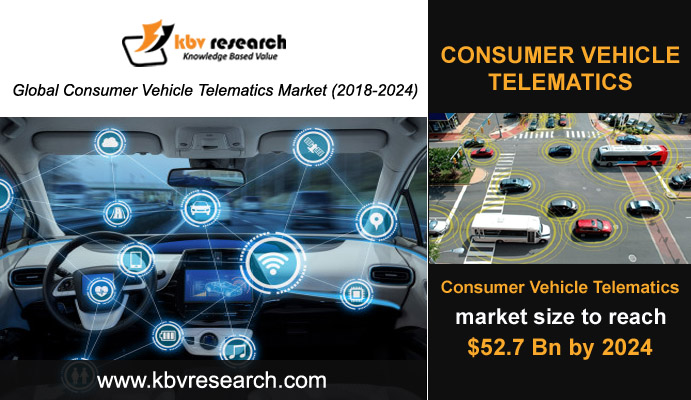Consumer Vehicle Telematics: A Paradigm Shift in Transport & Logistics
All about Consumer
Vehicle Telematics
Consumer
vehicle telematics is the technology and services meant for easy
transmission of communication within passenger cars in real time. These
services include in-car consumer services, GPS navigation, traffic, local
search (e.g. gas stations, restaurants) and concierge services. The growth in
the telematics marketplace is driven by the growing number of vehicle safety
and security regulatory requirements. Telematics is a new automobile
communication technology industry that combines wireless audio and visual data
that offer safety, information, productivity, and entertainment services to
drivers and passengers in a specific location.
 |
| Global Consumer Vehicle Telematics Market (2018-2024) |
Why deploy Consumer
Vehicle Telematics?
Increased use of mobile communications has provided insurers
with the means to build a mutually beneficial relationship with policyholders.
This has been more evident in the automotive insurance sector, which has
witnessed advances in the communication or telematics segment of
machine-to-machine (M2 M), generating data that helps to assess risks and
rewards for policyholders living up to safe driving practices. Telematics and
associated analysis tools are expected to contribute to streamlining and
automating claim processes by triggering and alerting real-time. This would
help greatly in reducing expenses for the insurers and is capable of driving
the consumer telematics demand significantly. Automobile manufacturers provide
connected vehicle services to consumers, which mainly include GPS, emergency
notifications, roadside assistance, etc.
What is the Original
Equipment Manufacturers (OEM) Deployment Mode?
An OEM is a manufacturer that produces products sold under
its own name by other companies. It is not surprising that telematics solutions
are becoming popular between the ability to track overall equipment usage and
to monitor engine data for more proactive maintenance. Telematics solutions arm
contractors and OEMs with strong insights to improve daily operations and
manage fleets more efficiently. To augment user adoption and satisfaction
rates, even more, OEM can influence new third-party solutions that wholly
comprehend user data – catapulting the years of development that takes OEM to
set-up an in-house telematics solution performing the same function.
Consumer Vehicle
Telematics and Infotainment
Telematics and infotainment seem to be in an automobile
collision path. The terms themselves are confusing. The combination of
telecommunications and IT, mainly wireless communication, refers to telematics.
The information and entertainment combination is understood as infotainment.
Vehicle infotainment systems are a combination of software and hardware to
provide information and entertainment features, such as GPS navigation, video
player, streaming music, SMS, hands-free, USB and Bluetooth connectivity,
internet in cars and Wi-Fi.
Industries and
Consumer Vehicle Telematics
·
Cars
(Personal & Rental)
Car rental companies and cab service providers use
telematics software and devices as this help them collect all the data
streaming via the asset from the distance, such as, for fuel consumption,
machine health, diagnostic information, fault codes, idle time, etc. Telematics
provided unprecedented volumes of driver performance data to fleet managers,
allowing for detection and handling of unwanted behaviors–including heavy
braking, hard cornering, and aggressive accelerations. All of these factors are
monitored by in-cab telematics systems, which directly send data to fleet
managers for evaluation.
·
Government
Agencies
Telematics provides the automotive sector with functionality
and risk assessment data that enables driving to be safe. Governments have an
important role to play in making telematics a mandatory requirement for car
industries, because they can avoid the number of road accidents, road jams,
over-velocities, etc. by means of telecommunications.
Government organizations may use telematics data for a
variety of applications such as accident statistical collection, regulatory
information, retrieval of safety data and improved road construction. Mandates
from the government and similar measures already provide the needs for
telematics systems. Hand-free mobile telephone mandates are rapidly increasing
due to driver difficulties. Low-end telematics with a voice user interface and
radio system integration will probably be the preferable solution. The
government also supplies the collection of electronic tolls, road, and active
safety information.
Consumer Vehicle
Telematics - In a Nutshell
The captured data can prevent engine failures and take
preventive maintenance. For the planning of future maintenance the collected
data is used. The technology of self-driving will change the transportation
system. Most people have been driving or relying on third-party services to
move around and ship their purchases. In the next five years, a company that
must remain competitive needs to upgrade to major telematics innovations. The
development of driverless vehicles for the transit of purchased products is one
of the innovations. The Consumer
Vehicle Telematics Market is projected to grow at a CAGR of 30.4% during the prediction period.
As proof of trade transactions, companies use the photo
reporting tool. Manual stamping of the location data is no longer necessary to
demonstrate the completion of the transaction. Advanced technology tools take
photos that they subsequently send to the reporting system in order to prove a
job completion. Telematics devices are equipped with a predictive servicing
feature that can diagnose any vehicle malfunction and warn drivers to take
immediate measures. For a certain period, diagnostic tools can monitor the
engine of the vehicle and its state.
Click Here For Free
Insights: https://www.kbvresearch.com/news/consumer-vehicle-telematics-market/
Visit here for Annual
Subscription Plan: https://www.kbvresearch.com/subscription-model/



Comments
Post a Comment